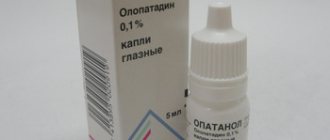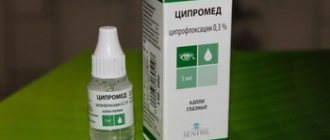special instructions
In patients using systemic quinolone drugs, severe, in some cases fatal, hypersensitivity reactions (anaphylaxis) were observed, sometimes immediately after taking the first dose (!). Some reactions were accompanied by collapse, loss of consciousness, angioedema (including swelling of the larynx and/or face), airway obstruction, shortness of breath, urticaria and pruritus. If the above conditions occur, resuscitation measures may be required. Long-term use of an antibiotic can lead to excessive growth of non-susceptible microorganisms, including fungi. In case of superinfection, it is necessary to discontinue the drug and prescribe adequate therapy. Do not touch the tip of the dropper bottle to any surface to avoid contamination of the bottle and its contents. The bottle must be closed after each use. Vigamox can be used in pediatrics in children from 1 year of age in doses similar to adults. After using the drug, a temporary decrease in the clarity of visual perception is possible, and until it is restored, it is not recommended to drive a car or engage in activities that require increased attention and reaction.
Vigamox
An antimicrobial agent from the fluoroquinolone group, it has a bactericidal effect. Shows activity against a wide range of gram-positive and gram-negative microorganisms, anaerobic, acid-fast and atypical bacteria: Mycoplasma spp., Chlamydia spp., Legionella spp. Treatment with the drug is effective against bacterial strains resistant to beta-lactam antibiotics and macrolides.
The active ingredient of the drug is effective against most strains of microorganisms: gram-positive - Staphylococcus aureus (including strains insensitive to methicillin), Streptococcus pneumoniae (including strains resistant to penicillin and macrolides), Streptococcus pyogenes (group A); gram-negative - Haemophilus influenzae (including both beta-lactamase-producing and non-beta-lactamase-producing strains), Haemophilus parainfluenzae, Klebsiella pneumoniae, Moraxella catarrhalis (including both beta-lactamase-producing and non-beta-lactamase-producing strains), Escherichia coli, Enterobacter cloacae; atypical - Chlamydia pneumoniae, Mycoplasma pneumoniae.
According to in vitro studies, although the microorganisms listed below are sensitive to the drug, its safety and effectiveness in the treatment of infections have not been established. Gram-positive microorganisms: Streptococcus milleri, Streptococcus mitis, Streptococcus agalactiae, Streptococcus dysgalactiae, Staphylococcus cohnii, Staphylococcus epidermidis (including strains sensitive to methicillin), Staphylococcus haemolyticus, Staphylococcus hominis, Staphylococcus saprophyticus, Staphylococcus simulans, Corynebacterium diphtheriae. Gram-negative microorganisms: Bordetella pertussis, Klebsiella oxytoca, Enterobacter aerogenes, Enterobacter agglomerans, Enterobacter intermedius, Enterobacter sakazakii, Proteus mirabilis, Proteus vulgaris, Morganella morganii, Providencia rettgeri, Providencia stuartii.
Anaerobic microorganisms: Bacteroides distasonis, Bacteroides eggerthii, Bacteroides fragilis, Bacteroides ovatus, Bacteroides thetaiotaomicron, Bacteroides uniformis, Fusobacterium spp., Porphyromonas spp., Porphyromonas anaerobius, Porphyromonas asaccharolyticus, Porphyromonas magnus, Prevot ella spp., Propionibacterium spp., Clostridium perfringens, Clostridium ramosum. Atypical microorganisms: Legionella pneumophila, Coxiella burnetii.
Blocks topoisomerases II and IV enzymes that control the topological properties of DNA and are involved in DNA replication, repair and transcription. The effect of the drug depends on its concentration in the blood and tissues. Minimum bactericidal concentrations are almost the same as the MIC.
There is no cross-resistance with penicillins, cephalosporins, aminoglycosides, macrolides and tetracyclines. The overall incidence of resistance is low. In vitro studies have shown that resistance to the drug develops slowly as a result of a series of sequential mutations. Cross-resistance is observed between drugs from the fluoroquinolone group. However, some gram-positive and anaerobic microorganisms that are resistant to other fluoroquinolones are sensitive to the drug.
Does not have a photosensitizing effect.
Composition and release form
The composition of eye drops is both simple and extremely effective. There is room here for the following components:
- moxifloxacin;
- sodium chloride;
- purified water;
- hydrochloric acid.
In the composition of Vigamox eye drops, there was a place for 5.45 mg. moxifloxacin, and thanks to such a large amount of the active substance, even advanced infections can be defeated in just 1-2 weeks.
The composition is available in bottles of 5 and 3 ml. These drops have a transparent color without impurities or yellowness. Drops are sold in cardboard packages, which also contain instructions for use.
Moxifloxacin – fourth generation fluoroquinol
A reliable drug for combating high intraocular pressure is Brinzopt eye drops.
Contraindications
You can find information online that infants are treated with eye drops. However, the instructions for Vigamox clearly state a contraindication regarding the patient’s age. It is not recommended to use it to treat children under one year of age.
Breastfeeding mothers should not use the drug. During lactation, the use of Vigamox can only be authorized by a doctor.
And, of course, you should not use the product if you have an individual intolerance to the components of the drug, especially mixifloxacin. The active substance can act quite aggressively on the body, so the presence of individual intolerances increases the risk of developing side effects.
Photophobia is a symptom of individual intolerance
Read here how to restore vision with myopia.
Indications for use
Elimination of inflammatory processes in the anterior parts of the eyes, caused by pathogenic microorganisms sensitive to moxifloxacin. Among the diseases for which drops can be prescribed are:
- blepharitis;
- conjunctivitis;
- meibomite;
- barley;
- keratitis;
- corneal ulcer;
- dacryocystitis.
The drug is also prescribed to prevent possible relapses of such diseases.
Prevention and treatment of inflammation of a bacterial nature that occurs against the background of injuries to the eyeball or surgical interventions.
Application nuances
Most often, the drug is prescribed for the treatment of a whole series of inflammatory diseases:
- conjunctivitis;
- keratitis;
- corneal ulcer;
- meibomitis;
- barley;
- dacryocystitis.
Vigamox eye drops can also be used if the eye apparatus is damaged due to injury or after surgery, when the risk of inflammation increases.
Symptoms and treatment methods for blepharitis in newborns are described in detail in the article.
The main symptom of bacterial conjunctivitis is purulent discharge
Why is the remedy so effective in combating a whole range of serious diseases? It's all about the active component, the antibiotic moxifloxacin, which directly affects pathogenic microorganisms, destroying them.
Drops are used both for the treatment and prevention of serious inflammatory diseases. In each case, the doctor prescribes his own dosage.
Comfort, vision correction and hydration all day long - Biofinity multifocal lenses.
It is important to observe the timing of use of the medicine after opening the bottle
A non-standard use of the toxin is the treatment of blepharospasm with Botox.
Methods of application
Vigamox is instilled into the affected eye or both eyes, 1 drop three times a day. The course of treatment is 4 days. After using the remaining drug, you should throw it away, since open drops have a limited shelf life.
Important! Do not touch the dropper with foreign objects or touch it with your hands to avoid a new round of infection.
Due to its effectiveness on antibiotic-sensitive microflora, the product successfully treats eye inflammation in children and even newborns.
To exclude the development of superinfection, it is important to develop a treatment regimen and implement it in a timely manner. It is not recommended to use the antibacterial agent for longer than the indicated period.
Possible adverse reactions of the body
The manufacturer notes that when its products are used correctly, no side effects occur. Most often, problems develop due to overdose or too frequent use.
Excellent vision is a reward for timely treatment
What complications may a patient suddenly encounter:
- Itching and pain in the eyes.
- Swelling and decreased visual acuity.
- Discharge from the eye.
- Sensitivity to light.
- Local hemorrhages.
- Feeling of a sour or metallic taste in the mouth, general taste disorder.
- Headache.
- Nausea or vomiting.
- Reduced hemoglobin.
- Feeling of a lump in the throat.
- Rash or itching on the skin.
- Cardiopalmus.
In rare cases, the patient may experience fainting or anaphylactic shock. However, these complications develop only with a severe overdose or acute allergic reaction to the components of the drug.
In order not to encounter the listed adverse reactions, the patient should carefully study all the doctor’s recommendations and try not to violate them. Usually, experts clearly prescribe the dosage and period of use of Vigamox.
Anatomy of the eye
This article will help you understand the reasons why it hurts to move your eyes.
Vigamox eye drops
Vigamox is an eye drop that has an antibacterial effect on many pathogenic microorganisms.
In this regard, they must be used for confirmed infection, which can be detected by an ophthalmologist.
The drug has a number of side effects and contraindications, so its use for certain categories of patients is limited.
The composition of the product allows you to treat inflammatory eye diseases that are caused by a bacterial infection.
Indications for use
Doctors prescribe the drug when the following conditions occur:
The use of the drug must be approved by a physician. It takes into account the presence of side effects and contraindications. If used incorrectly, pathogenic microorganisms may develop resistance to the active substance.
Price
The drug has a low cost, due to which many patients purchase it. The average cost in pharmacies varies between 200-400 rubles.
Compound
The drug is multicomponent, due to which the maximum effect from its use is achieved:
- Moxifloxacin is the main active ingredient that ensures the destruction of bacteria and suppression of their growth;
- sodium hydrochloride – provides hydration of the mucous membrane of the eyes;
- boric acid – has an antiseptic effect against bacteria and fungi;
- hydrochloric acid – has an antiseptic effect;
- water for injection is a sterile liquid designed to dissolve active substances.
If the drops correspond to the expiration date, the solution is colorless. After its expiration, it becomes yellowish. Containers for 3 and 5 ml are available.
Instructions for use
Before using the drug, you must wash your hands with bactericidal soap to prevent infection or bacteria from getting inside the bottle. After this, the head is thrown back and the bottle is brought to the eyes.
Pull back the lower eyelid and instill 1 drop into each eye. The product should reach the area of the conjunctival sac. The duration of therapy is determined by the doctor.
It should not exceed 10 days, since after this time the bacteria develop resistance to the active substance.
For children
Instructions for use for children and adults are similar. It is not recommended to use the drug to treat children under 1 year of age. Before using the solution, you should consult your pediatrician to avoid side effects. If the child’s condition changes after using the drops, they should be discontinued immediately.
special instructions
When using medicinal drops, you should follow some instructions, which you should discuss with your doctor first:
- Wearing contact lenses. If the patient uses one-day models, simultaneous use of the drug with them is allowed. In this case, the contact lenses are removed, liquid is instilled, and replaced after 20 minutes.
- If a patient uses contact lenses that last more than one day, doctors recommend replacing them with glasses during treatment. This is due to the fact that the active substance will accumulate in the porous structure of the lenses.
- It is recommended not to drive a vehicle immediately after instilling the product. This is because the drug may cause temporary clouding of the eyes.
Interaction with other drugs
Sufficient studies have not been conducted on the interaction of moxifloxacin with other drugs. Unlike other fluoroquinolone drugs, there is no cross-reaction with warfarin, dioxin, oral contraceptives, or other antibiotics. This allows for joint therapeutic measures and the use of complex treatment.
Moxifloxacin does not reduce the effect of enzymatic drugs, so it can be used in conjunction with cytochromes.
Pregnancy and lactation
The action of the drops is based on the substance moxifloxacin. It is able to penetrate the placental barrier, causing a teratogenic effect on the fetus. Its development may be slowed down or disrupted. Therefore, the drug is contraindicated during pregnancy.
If a woman is breastfeeding, the product is also contraindicated. This is due to the fact that it actively penetrates into mother’s milk, negatively affecting the baby’s organs. Possible slowdown in development, dyspeptic disorders (nausea, vomiting, frequent regurgitation), neuralgia (increased agitation, frequent awakening at night).
Side effects
The drug affects the human body locally and systemically. In this regard, side effects are divided into these areas.
Side effects of local exposure:
- increased intraocular pressure, which can cause drug-induced glaucoma;
- inflammatory condition of the eyelids;
- pathological deposits on the cornea;
- blurred eyes;
- development of allergic reactions in the form of itching, burning, irritation, swelling, inflammation of the eyes and eyelids.
Side effects of systemic exposure:
- tachycardia;
- unpleasant taste in the mouth;
- dyspeptic reactions in the form of vomiting or nausea;
- dizziness.
There is a category of patients who have contraindications to the use of the active substance on which Vigamox is based. Severe cases of allergic reactions occur, leading to anaphylactic shock. The following severe allergic reactions may also occur:
- Quincke's edema;
- collapse (collapse of blood vessels);
- obstruction of the bronchial tract, leading to acute respiratory failure;
- urticaria and skin itching.
In case of the above reactions, immediate medical measures are necessary.
Contraindications
Doctors often recommend Vigamox eye drops when a bacterial infection occurs, as they have a few contraindications:
- increased sensitivity to the components of the drug, manifested in the form of adverse reactions and allergies;
- state of pregnancy or breastfeeding;
- children under 1 year of age;
- cataract;
- glaucoma;
- serious blood diseases;
- fungal eye diseases;
- viral nature of eye damage.
If there are contraindications to a drug, the doctor can choose an analogue that does not have them.
The use of antibiotics for more than 10 days is prohibited. Bacteria will lose susceptibility to the drug. Fungal formations will appear. A superinfection may occur that cannot be treated.
Overdose
There have been no cases of overdose with Vigamox eye drops. Possible accidental or special ingestion of liquid by adults or children.
In this case, it is necessary to give the victim activated carbon and call an ambulance. The doctor may prescribe gastric lavage.
Next, symptomatic therapy will be carried out aimed at eliminating allergic reactions, cardiovascular disorders, and fever.
In case of minor overdose in the eye area, rinse them with warm water. In this case, you do not need to see a doctor.
Analogs
If side effects occur, there are contraindications, or there are no results from using the drug, it is replaced with an analogue. Vigamox drops can be replaced with the following drugs:
- Phloxal;
- Moxifloxacin;
- Levomycetin;
- Tobrex or Tobradex.
More details about analogues can be found here
It is not recommended to replace the drug on your own. You should consult your doctor first to prevent the risk of side effects.
Reviews from doctors
Eremina Daria, ophthalmologist: If patients come to me with a bacterial eye infection, I often recommend Vigamox eye drops. They not only have a bactericidal effect, but also effectively eliminate inflammation. The advantage of the drug is the small number of contraindications.
Vladimir Strelnikov, ophthalmologist: I often see patients who develop resistance to most antibacterial drugs. In this case, I prescribe Vigamox eye drops, to which many pathogenic microorganisms are sensitive. I pre-assign patients testing to detect antibiotic resistance in bacteria.
Reviews
Fedor: Recently I began to have profuse discharge from my eyes, which was yellowish. I went to the ophthalmologist, he said it was conjunctivitis. He prescribed me Vigamox eye drops. The discharge from the eyes disappeared the next day. But the doctor said that it is necessary to continue therapy for one week to prevent the recurrence of the disease.
Alexey: I often get stye on my eyes. This really interferes with my life. I visited many doctors. The latter prescribed me Vigamox drops. The manifestations of barley quickly disappeared. I hope that the disease will not arise again in the near future.
Shelf life and storage
The shelf life of the drug is 2 years from the date of its manufacture. If the bottle has been opened, it is reduced to 1 month. This is due to the fact that the sterility of the packaging is compromised. Pathogenic microorganisms penetrate inside, changing the composition of the product.
The drug should be stored at room temperature. The packaging must not be kept within reach of children. It should not be exposed to direct sunlight or moisture.
Poor vision significantly worsens the quality of life and makes it impossible to see the world as it is.
Not to mention the progression of pathologies and complete blindness.
MNTK "Eye Microsurgery" published an article on non-surgical restoration of vision up to 90%, this became possible thanks to...
Read more Was this article helpful?
Rate the material on a five-point scale!
( 9 4.22
Source: https://proglazki.ru/kapli-dlya-glaz/vigamoks/










